The Lydian mode is the fourth mode of the Major scale and is a great way to add a dreamy or mysterious quality to your music.
Before you learn Lydian or any other modes, I recommend first learning the Ionian mode to give you a basic starting point.
This guide will look at:
- What the Lydian mode is
- How the Lydian mode compares to other modes
- Basic Music Theory and Mode Formula
- Fretboard Diagrams for Every Lydian Mode on Guitar
- How to Use the Lydian Mode
- Songs Using the Lydian Mode
After reading this guide, read this guide to learn how to practice modes and scales.
What is the Lydian Mode
The Lydian mode is the fourth mode of the Major scale. This means the Lydian mode can be built by looking at the fourth note of any Major scale.
The Lydian mode’s raised fourth sets it apart from every other mode as you will see later in this guide.
Many guitarists use the Lydian mode to add a bright and dreamy mood to their playing.
Lydian is a Major mode, so it’s often thought of as having a bright or happy sound, while having a mysterious or fantasy feel to it.
Lydian is also a great example of how changing one note can completely change the feel of a mode.
Once you learn the Ionian mode, I highly recommend learning Lydian to see what all the fuss is about with modes.
Lydian Mode Formula
The Lydian mode can be understood with a formula that compares it against the Major scale. Understanding mode formulas will help you understand the difference between each mode.
The formula for the Lydian mode is: 1 2 3 #4 5 6 7
If you compare this to the formula for the Major Scale (1 2 3 4 5 6 7), you will see there is only one note difference between Lydian and the Major Scale.
The fourth note is raised by one semitone (one fret on guitar) to create the Lydian mode. All the other notes are the same as the Major Scale. This raised fourth note is what gives Lydian its dreamy quality.
Because the Lydian mode is a Major mode, it works best when played over Major chords as covered later.
How to Find The Notes in Lydian
There are three different methods you can use to find the notes in any mode.
Modes are often confusing at first because different books and videos will use different methods to explain modes, so you end up with a confusing blur of explanations.
I’ll go through the three easiest ways to find the notes in the Lydian mode and you can decide which method makes the most sense to you to use.
Method 1: Use the Mode Formula
The first method to figure out the notes in any mode is to use the mode formula as mentioned earlier.
The formula for Lydian is: 1 2 3 #4 5 6 7
To use this formula, pick a root note for the mode you want to figure out.
Here are the steps to using the mode formula to find the notes in any mode:
- Choose a mode to learn
- Find the Major Scale that starts on the same note
- Use the mode formula to change that scale into the mode
Let’s go through these steps with a couple of examples to show how you can use the formula to figure out any Lydian mode. But the same above steps apply when learning other modes.
Example 1: C Lydian
Let’s say you want to figure out the notes for C Lydian.
The root note (the first note) for C Lydian is C. This means to use the mode formula, we need to start with the notes in the C Major Scale. You simply find the scale that matches the starting note C.
Here are the notes of the C Major Scale:

Now we can use the Lydian formula (1 2 3 #4 5 6 7) to change the C Major scale into the C Lydian mode.
The ‘#’ before the number tells us that the note needs to be raised by one semitone or a half-step (one fret on guitar). We call this a raised fourth or augmented fourth (learn about intervals here).
The only note that needs to change is the fourth note. All the other notes stay the same as the notes in the C Major Scale.
The fourth note in the C Major Scale is F. When we raise this by one semitone (one fret), we get F#.
Here’s a chart comparing the C Major scale to the notes in the C Lydian mode:

By changing the fourth note in the C Major scale, we end up with all the notes in the C Lydian mode.
The notes in C Lydian are: C D E F# G A B
Example 2: F Lydian
The root note (the first note) for F Lydian is F. This means to use the mode formula, we need to start with the notes in the F Major Scale.
Here are the notes of the F Major Scale:

The formula for Lydian is 1 2 3 #4 5 6 7 so we need to raise the fourth note in the F Major scale by one fret to find the notes for F Lydian. All the other notes stay the same.
The fourth note in the F Major scale is Bb (B flat), so to create a raised fourth, we raise it by one fret to get the note B.
Here’s a chart comparing the F Major scale to the F Lydian mode:

So the notes in F Lydian are: F G A B C D E.
The sharps and flats used to create modes may be confusing if you are new to music theory, so think of them as shifting up or down a fret at a time. If you see ‘b3’, it just means take the ‘3’ note and move it down one fret. If you see a ‘#4’, it just means to take the ‘4’ note and raise it by one fret.
The starting note could be anything (eg: C#, Eb, F) and it doesn’t make any difference – just move it down one fret to find the new note (raising Bb by one fret is B).
Practice taking other Major scales and turning them into the Lydian mode using the above formula and steps.
Method 2: Match the Major Scale
The second method is to figure out which Major scale matches the mode you want to find.
There are seven modes of the Major scale – one built from every note in the scale.
Lydian is the fourth mode of the Major scale, so Lydian is built using the fourth note of the Major scale.
Example 1: F Lydian
We want to find a Major scale that uses the note ‘F’ as the fourth note in the scale.
An easy way to do this is to look up a chart of Major scales to find the one that uses F in the fourth position.
The other way is to look at the note five frets down from your chosen Lydian mode root.
Five frets down from F is C, so the matching Major scale for F Lydian is the C Major scale (C D E F G A B).
This means the C Major scale and the F Lydian mode use the same notes. The only difference is F Lydian starts on F and C Major starts on C.
So the notes in F Lydian are: F G A B C D E.
Example 2: A Lydian
We want to find a Major scale that uses the note ‘A’ as the fourth note in the scale.
You can look up a chart of Major scales to find the one that uses A in the fourth position.
The other way is to look at the note five frets down from your chosen Lydian mode root.
Five frets down from A is E, so the matching Major scale is the E Major scale (E F# G# A B C# D#).
This means the E Major scale and the A Lydian mode use the same notes. The only difference is A Lydian starts on A and E Major starts on E.
So the notes in A Lydian are: A B C# D# E F# G#.
Method 3: Build Using Intervals
The third method is to build the mode using intervals and an interval formula.
Intervals are the building blocks of scales as explained in detail in this lesson.
Learning how to build a scale or mode using intervals will help you understand what makes each mode or scale different.
The way you build the Lydian mode using intervals is similar to how we built the mode using the formula covered earlier.
The interval formula for the Lydian mode is: W W W H W W H
W = whole-tone (two frets on guitar)
H = half-tone or semitone (one fret on guitar)
To use this formula, you pick the mode you want to build (eg: C Lydian), then follow the formula to figure out the rest of the notes.
Once you learn how to do this, you’ll see that you can easily build any Lydian mode you want without having to know any Major scales.
Example: E Lydian
Here’s a fretboard diagram showing how simple this method is to work out the E Lydian mode:

Here are the steps explained:
- Start on the root note for the mode (eg: E for E Lydian)
- Move up two frets to find the next note for any W in the formula
- Move up one fret to find the next note for any H in the formula
- By the end of the formula, you should end up on the same note as the root one octave higher (eg: E for E Lydian)
Once you memorize the formulas for all seven modes, you can easily find all the notes to any mode without having to look up any scale.
This method might seem like a lot of work at first, but if you have memorized the notes on the fretboard, you’ll find that this is an incredibly quick and easy method to use.
Lydian Mode Reference Chart
Here is a handy reference chart showing all possible Lydian Modes:

Every Lydian Mode Fretboard Diagram
There are 12 possible Lydian modes to match the 12 notes we can play on guitar.
Before we look at how to use the Lydian mode as well as songs that use Lydian, here is a fretboard diagram for every Lydian mode you can play on guitar.
A Lydian Fretboard Diagram
The notes in A Lydian mode are: A B C# D# E F# G#
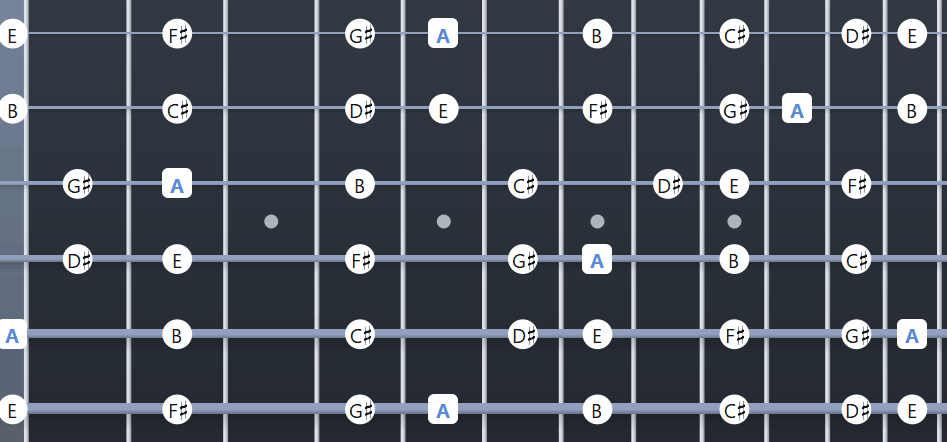
Bb Lydian Fretboard Diagram
The notes in Bb Lydian mode are: Bb C D E F G A
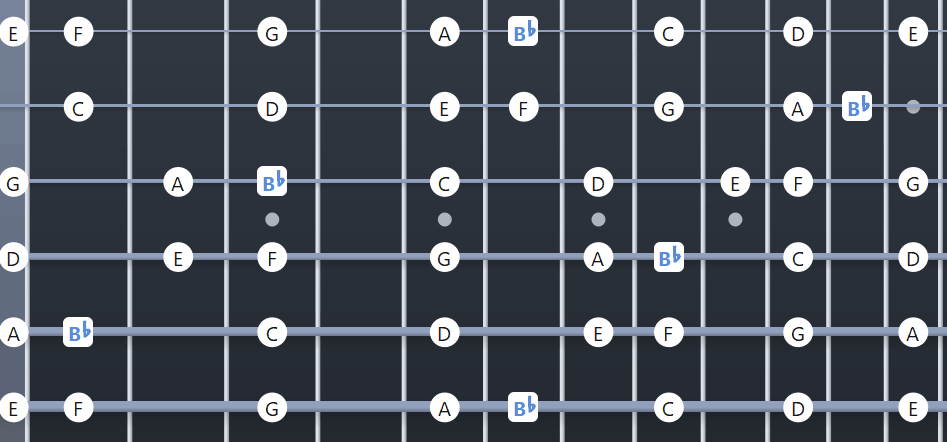
C Lydian Fretboard Diagram
The notes in C Lydian mode are: C D E F# G A B

Db Lydian Fretboard Diagram
The notes in Db Lydian mode are: Db Eb F G Ab Bb C

D Lydian Fretboard Diagram
The notes in D Lydian mode are: D E F# G# A B C#
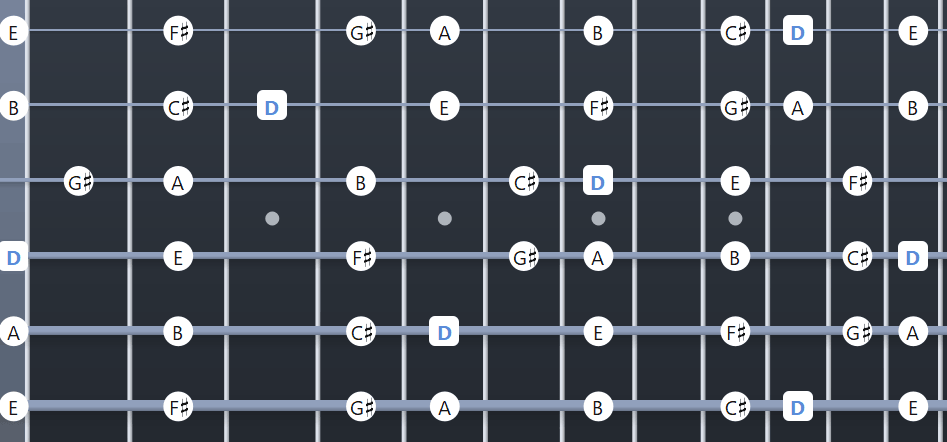
Eb Lydian Fretboard Diagram
The notes in Eb Lydian mode are: Eb F G A Bb C D

E Lydian Fretboard Diagram
The notes in E Lydian mode are: E F# G# A# B C# D#

F Lydian Fretboard Diagram
The notes in F Lydian mode are: F G A B C D E
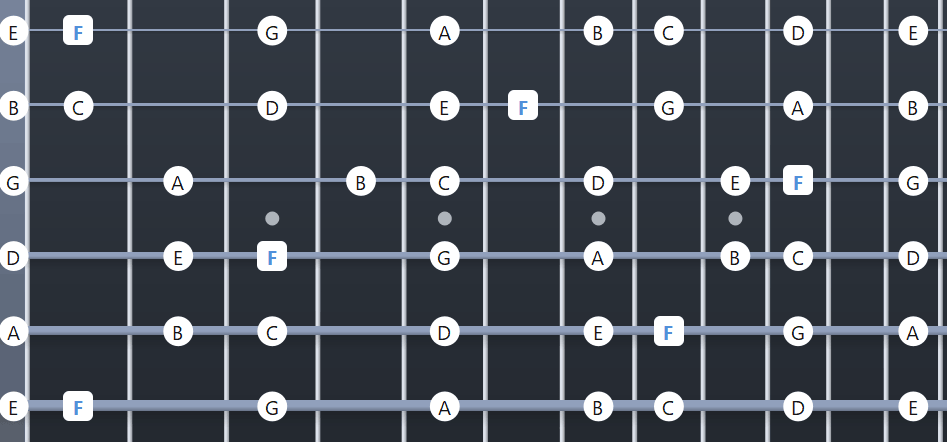
Gb Lydian Fretboard Diagram
The notes in Gb Lydian mode are: Gb Ab Bb C Db Eb F
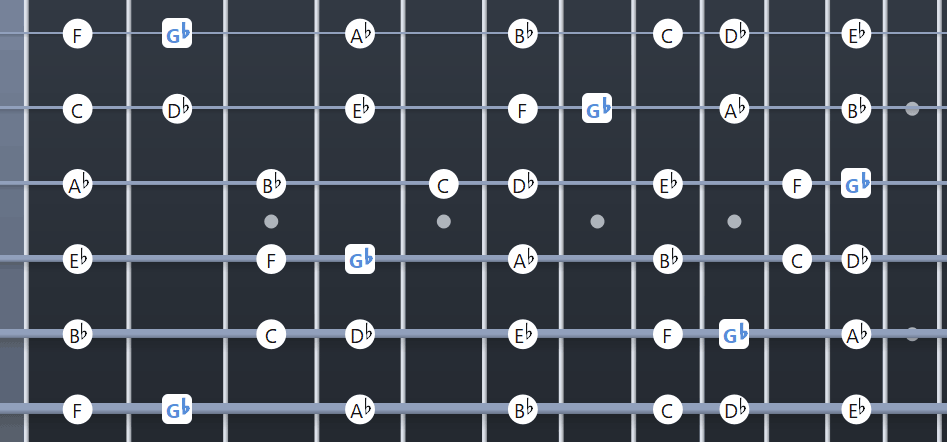
G Lydian Fretboard Diagram
The notes in G Lydian mode are: G A B C# D E F#

Ab Lydian Fretboard Diagram
The notes in Ab Lydian mode are: Ab Bb C D Eb F G
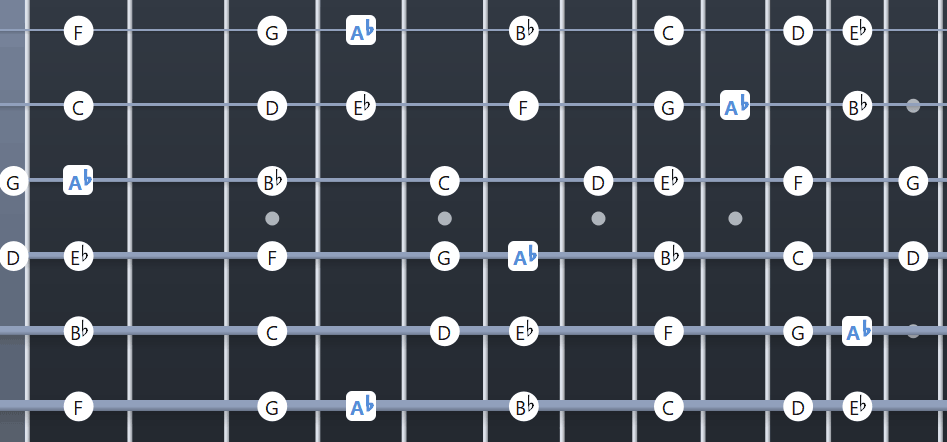
How to Use the Lydian Mode
The best way to learn how to use the Lydian mode is to spend time jamming with it over the top of a Major chord.
For example, use a looper pedal to record yourself strumming an E Major chord, an Emaj7, or an Emaj7#11 (to emphasize the Lydian sound).
Now you can jam over the top of that chord using the E Lydian mode. Try coming up with licks and melodies and listen to how the mode sounds over the top of the chord.
Make sure you match the minor chord to the root note of the mode you’re using. So if you want to jam in A Lydian, play over an A Major chord.
The Lydian Sound
When you play through the notes in the Lydian mode, there’s one note that should stand out to your ears compared to the rest.
Compared to the Major scale, the Lydian mode uses a raised fourth (#4) and this note can create a very dreamy, mysterious, or unusual sound to your music.
When you play the Major scale and compare it against the Lydian mode, this raised fourth clearly stands out as unusual.
Play through the notes in the Lydian mode over a background Major chord and listen carefully to each note.
For example, try playing the below notes (E Lydian) over the top of an E Major chord:
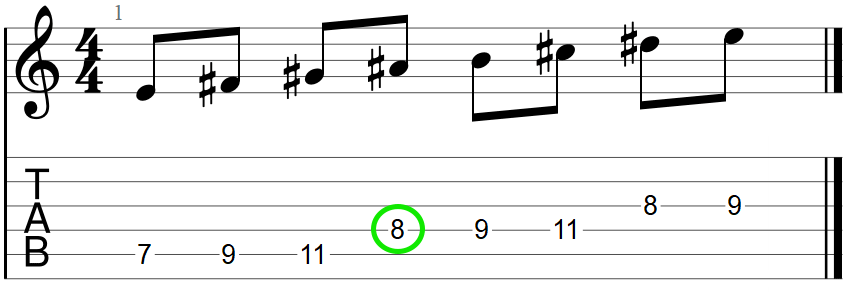
The above Guitar TAB starts on E and ends on E after going through all the notes in E Lydian.
The note that stands out is the fourth note in Lydian. This note (#4) in E Lydian is A# (highlighted above in green). Listen carefully to how this note sounds against the backing Major chord to get a sense of the Lydian sound.
If you were to skip playing this #4 note, your ears would simply hear the Major sound skipping the fourth note. This means if you want to bring out the Lydian sound in your playing, you need to make sure you play and emphasize the #4 note.
When you listen to the songs using the Lydian mode covered later, listen out for the #4 note. When you get used to how this note sounds, you’ll be able to easily identify Lydian in songs by ear.
Comparing Lydian to Other Modes
The best way to truly understand the sound of Lydian is to directly compare it against other modes.
Start by improvising using E Lydian over your low E string droning in the background.
Then switch to another mode based on E such as E Dorian or E Phrygian and think about how each mode sounds different.
Some modes will have a dark or minor quality while others will sound brighter and cheery. Lydian will have a very bright and upbeat quality compared to some other modes.
Everybody describes modes in different ways, so try to create your own mental label of how each mode sounds to help you identify them in music.
Remember to think about the altered notes in each mode (eg: #4 in Lydian) and to focus on playing those notes to emphasize the differences in each mode.
Songs Using the Lydian Mode
Lydian is a popular mode for solo instrumental guitarists such as Joe Satriani and Steve Vai. Many of their songs heavily feature the Lydian mode.
Have a listen to the following songs and see if you can get a feel for the Lydian sound. With enough practice, you’ll start to recognize all the different modes in music by ear.
See if you can pick out the #4 note in each song – the note that separates Lydian from the Major scale.
Here are some songs that are great examples of the Lydian mode:
- Flying in a Blue Dream by Joe Satriani
- K’m Pee Du Wee by Steve Vai
- The Simpsons Theme Song
- Freewill by Rush
- Dreams by Fleetwood Mac
- Man on the Moon by R.E.M.
- Oceans by Pearl Jam
Look up the Guitar TAB for these songs and see if you can figure out exactly what Lydian mode is used in each one. Compare the notes used in the song against the fretboard diagrams from earlier and you can figure out each mode.
Lydian Mode FAQs
Here are some common questions you might have about the Lydian mode.
What is Lydian Mode Good For?
The Lydian mode is good for when you want to add a dreamy or mysterious sound to your playing. It is a bright and upbeat-sounding mode with an interesting sound that isn’t found in any other mode.
Why Does Lydian Sound Good?
The Lydian mode sounds good because it only has one note different than the Major scale. This means the sound you hear when playing Lydian is very recognizable as a Major scale sound, but the altered note (the raised fourth) adds something different to Lydian.
Can You Play Lydian Over Major?
Lydian works best when played over a Major chord. When a Major chord is playing or a Major seventh chord, play the Lydian mode and make sure you match the Lydian mode to the root of the chord playing.
For example, if there is an Emaj7 chord playing, you would play the E Lydian mode.
Where is Lydian Mode Used?
Lydian mode is used whenever you want to get a dreamy or mysterious sound over the top of a Major chord. Lydian is used in many different styles of music to add something fresh or interesting.
Is Lydian Major?
Yes. Lydian can be thought of as a Major mode because of the Major third, sixth, and seventh intervals used. The Lydian mode can be thought of as the Major scale with a raised fourth, so you end up with a very ‘Major’ sounding mode.
Here are more useful guides on the modes and practicing them:
- Guide to Ionian Mode
- Guide to Dorian Mode
- Guide to Phrygian Mode
- Guide to Mixolydian Mode
- Guide to Aeolian Mode
- How to Practice Guitar Scales and Modes
- How to Memorize the Fretboard
- More guides on modes coming soon
